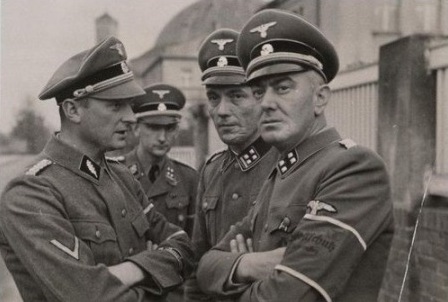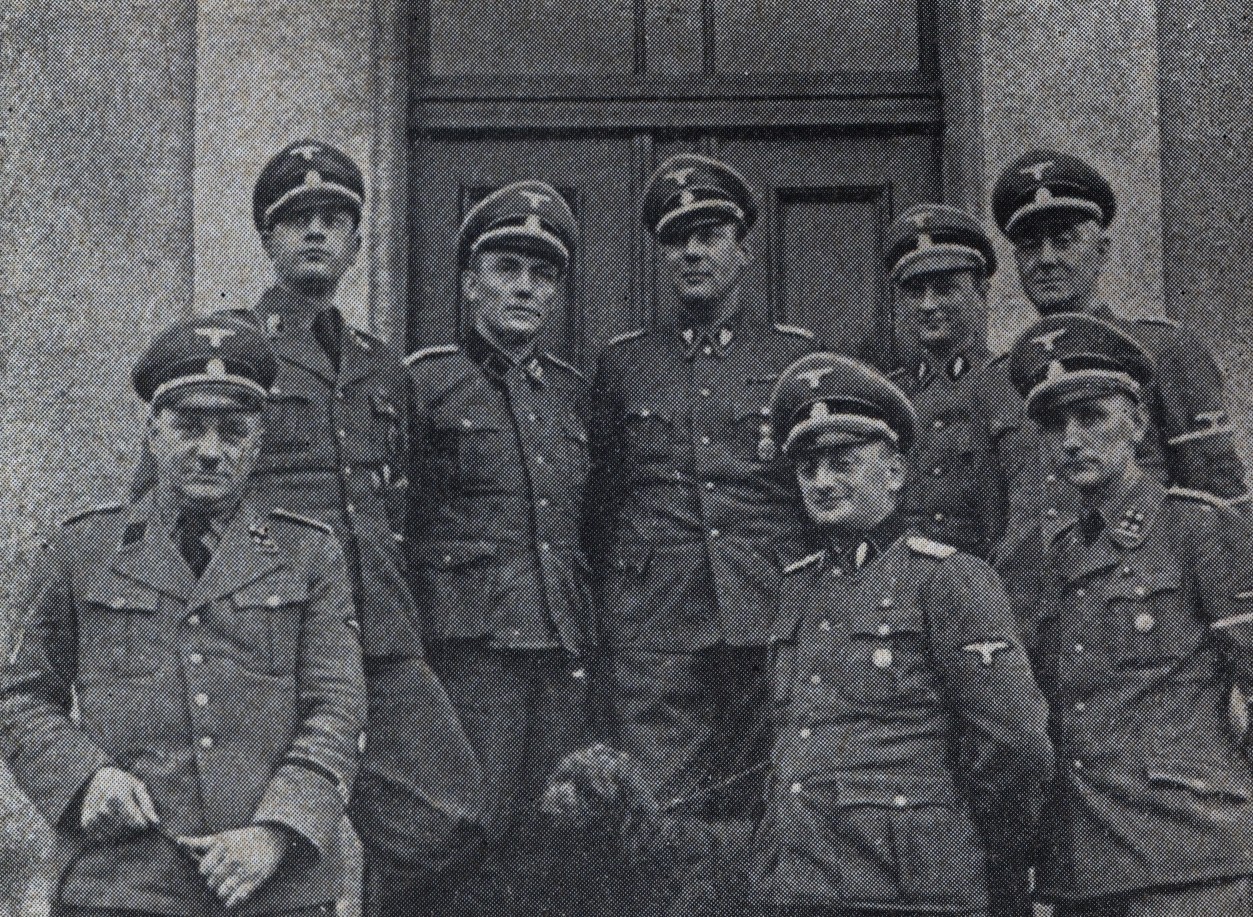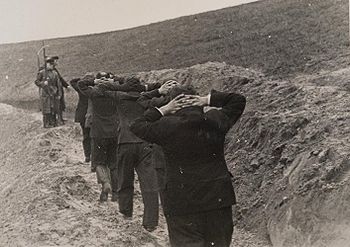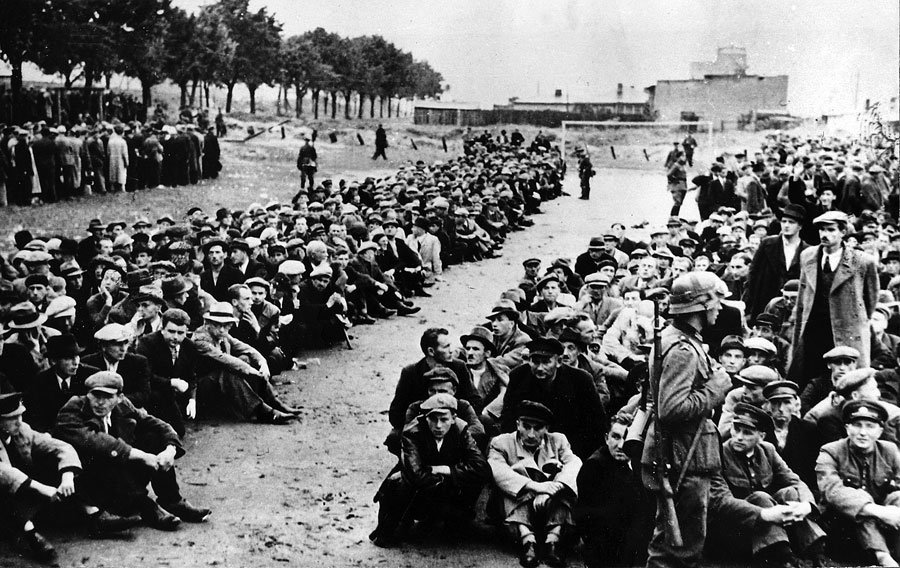|
Valley Of Death (Bydgoszcz)
Valley of Death ( pl, Dolina Śmierci) in Fordon, Bydgoszcz, northern Poland, is a site of Nazi German mass murder committed at the beginning of World War II and a mass grave of 1,200–1,400 Poles and Jews murdered in October and November 1939 by the local German ''Selbstschutz'' and the Gestapo.Encyklopedia PWNIntelligenzaktion. September–November 1939. Kampania Wrześniowa 1939.pl (2006). Retrieved 2 November 2015. The murders were a part of Intelligenzaktion in Pomerania, a action aimed at the elimination of the |
Intelligenzaktion Pommern
The ''Intelligenzaktion Pommern''Stefan Sutkowski (2001), ''The history of music in Poland: The Contemporary Era. 1939–1974''. Vol. 7, page 37 "...some 183 professors of the Jagiellonian University and the Academy of Mining and Foundry in Cracow were arrested, with similar actions undertaken in Pomerania and Silesia (known as the Intelligenzaktion Pommern und Schlesien)"(Google Books). was a Nazi German operation aimed at the eradication of the Polish intelligentsia in Pomeranian Voivodeship and the surrounding areas at the beginning of World War II. It was part of a larger genocidal ''Intelligenzaktion'' that took place across most of Nazi-occupied western Poland in the course of Operation Tannenberg (''Unternehmen Tannenberg''), purposed to install Nazi officials from SiPo, Kripo, Gestapo and SD at the helm of a new administrative machine. On the direct orders from Adolf Hitler, carried out by Reinhard Heydrich's bureau of ''Referat Tannenberg'' along with Heinrich Himmler� ... [...More Info...] [...Related Items...] OR: [Wikipedia] [Google] [Baidu] |
Selbstschutz
''Selbstschutz'' (German for "self-protection") is the name given to different iterations of ethnic-German self-protection units formed both after the First World War and in the lead-up to the Second World War. The first incarnation of the ''Selbstschutz'' was a German paramilitary organisation formed after World War I for ethnic Germans who lived outside Germany in the territories occupied by Germany and Austria-Hungary following the conclusion of the Treaty of Brest-Litovsk. The purpose of these units was to protect local ethnic-German communities and, indirectly, to serve German security interests in southern Ukraine. Another iteration of the ''Selbstschutz'' concept was established in Silesia and aimed at returning Polish-inhabited territories back to Germany following the rebirth of Poland. In 1921, the units of ''Selbstschutz'' took part in the fights against the Polish Third Silesian Uprising. The third incarnation operated in territories of Central and Eastern Europe befor ... [...More Info...] [...Related Items...] OR: [Wikipedia] [Google] [Baidu] |
Priest
A priest is a religious leader authorized to perform the sacred rituals of a religion, especially as a mediatory agent between humans and one or more deities. They also have the authority or power to administer religious rites; in particular, rites of sacrifice to, and propitiation of, a deity or deities. Their office or position is the 'priesthood', a term which also may apply to such persons collectively. A priest may have the duty to hear confessions periodically, give marriage counseling, provide prenuptial counseling, give spiritual direction, teach catechism, or visit those confined indoors, such as the sick in hospitals and nursing homes. Description According to the trifunctional hypothesis of prehistoric Proto-Indo-European society, priests have existed since the earliest of times and in the simplest societies, most likely as a result of agricultural surplus and consequent social stratification. The necessity to read sacred texts and keep temple or church rec ... [...More Info...] [...Related Items...] OR: [Wikipedia] [Google] [Baidu] |
Teacher
A teacher, also called a schoolteacher or formally an educator, is a person who helps students to acquire knowledge, competence, or virtue, via the practice of teaching. ''Informally'' the role of teacher may be taken on by anyone (e.g. when showing a colleague how to perform a specific task). In some countries, teaching young people of school age may be carried out in an informal setting, such as within the family (homeschooling), rather than in a formal setting such as a school or college. Some other professions may involve a significant amount of teaching (e.g. youth worker, pastor). In most countries, ''formal'' teaching of students is usually carried out by paid professional teachers. This article focuses on those who are ''employed'', as their main role, to teach others in a ''formal'' education context, such as at a school or other place of ''initial'' formal education or training. Duties and functions A teacher's role may vary among cultures. Teachers may provide ... [...More Info...] [...Related Items...] OR: [Wikipedia] [Google] [Baidu] |
Intelligentsia
The intelligentsia is a status class composed of the university-educated people of a society who engage in the complex mental labours by which they critique, shape, and lead in the politics, policies, and culture of their society; as such, the intelligentsia consists of scholars, academics, teachers, journalists, and literary writers. Conceptually, the intelligentsia status class arose in the late 18th century, during the Partitions of Poland (1772–1795). Etymologically, the 19th-century Polish intellectual Bronisław Trentowski coined the term ''inteligencja'' (intellectuals) to identify and describe the university-educated and professionally active social stratum of the patriotic bourgeoisie; men and women whose intellectualism would provide moral and political leadership to Poland in opposing the cultural hegemony of the Russian Empire. In pre–Revolutionary (1917) Russia, the term ''intelligentsiya'' (russian: интеллигенция) identified and described the s ... [...More Info...] [...Related Items...] OR: [Wikipedia] [Google] [Baidu] |
Pomnik W Dolinie Smierci
{{Kętrzyn-geo-stub ...
Pomnik (German ''Pomnick'') is a village in the administrative district of Gmina Korsze, within Kętrzyn County, Warmian-Masurian Voivodeship, in northern Poland. It lies approximately north-east of Korsze, north-west of Kętrzyn, and north-east of the regional capital Olsztyn. The village has a population of 86. References Pomnik Pomnik (German ''Pomnick'') is a village in the administrative district of Gmina Korsze Gmina Korsze is an urban-rural gmina (administrative district) in Kętrzyn County, Warmian-Masurian Voivodeship, in northern Poland. Its seat is the town of ... [...More Info...] [...Related Items...] OR: [Wikipedia] [Google] [Baidu] |
Saul Friedländer
Saul Friedländer (; born October 11, 1932) is a Czech-Jewish-born historian and a professor emeritus of history at UCLA. Biography Saul Friedländer was born in Prague to a family of German-speaking Jews. He was raised in France and lived through the German Occupation of 1940–1944. From 1942 until 1946, Friedländer was hidden in a Catholic boarding school in Montluçon, near Vichy. While in hiding, he converted to Roman Catholicism and later began preparing for the Catholic priesthood. His parents attempted to flee to Switzerland, were arrested instead by Vichy French ''gendarmes'', turned over to the Germans and were gassed at the Auschwitz concentration camp. Not until 1946 did Friedländer learn the fate of his parents. After 1946, Friedländer grew more conscious of his Jewish identity and became a Zionist. In 1948, Friedländer immigrated to Israel on the Irgun ship ''Altalena''. After finishing high school, he served in the Israel Defense Forces. From 1953 to 1955, he ... [...More Info...] [...Related Items...] OR: [Wikipedia] [Google] [Baidu] |
Operation Tannenberg
Operation Tannenberg (german: Unternehmen Tannenberg) was a codename for one of the anti-Polish extermination actions by Nazi Germany that were directed at the Poles during the opening stages of World War II in Europe, as part of the ''Generalplan Ost'' for the German colonization of the East. The shootings were conducted with the use of a proscription list ('' Sonderfahndungsbuch Polen''), compiled by the Gestapo in the span of two years before the 1939 invasion. The top secret lists identified more than 61,000 members of the Polish elite: activists, intelligentsia, scholars, clergy, actors, former officers and others, who were to be interned or shot. Members of the German minority living in Poland assisted in preparing the lists.Unt ... [...More Info...] [...Related Items...] OR: [Wikipedia] [Google] [Baidu] |
Genocide
Genocide is the intentional destruction of a people—usually defined as an ethnic, national, racial, or religious group—in whole or in part. Raphael Lemkin coined the term in 1944, combining the Greek word (, "race, people") with the Latin suffix ("act of killing").. In 1948, the United Nations Genocide Convention defined genocide as any of five "acts committed with intent to destroy, in whole or in part, a national, ethnical, racial or religious group." These five acts were: killing members of the group, causing them serious bodily or mental harm, imposing living conditions intended to destroy the group, preventing births, and forcibly transferring children out of the group. Victims are targeted because of their real or perceived membership of a group, not randomly. The Political Instability Task Force estimated that 43 genocides occurred between 1956 and 2016, resulting in about 50 million deaths. The UNHCR estimated that a further 50 million had been displac ... [...More Info...] [...Related Items...] OR: [Wikipedia] [Google] [Baidu] |
Polish Corridor
The Polish Corridor (german: Polnischer Korridor; pl, Pomorze, Polski Korytarz), also known as the Danzig Corridor, Corridor to the Sea or Gdańsk Corridor, was a territory located in the region of Pomerelia (Pomeranian Voivodeship, eastern Pomerania, formerly part of West Prussia), which provided the Second Republic of Poland (1920–1939) with access to the Baltic Sea, thus dividing the bulk of Germany (Weimar Republic) from the province of East Prussia. At its narrowest point, the Polish territory was just 30 km wide. The Free City of Danzig (now the Polish cities of Gdańsk, Sopot and the surrounding areas), situated to the east of the corridor, was a semi-independent German speaking city-state forming part of neither Germany nor Poland, though united with the latter through an imposed union covering customs, mail, foreign policy, railways as well as defence. A similar territory, also occasionally referred to as a corridor, was originally connected to the Polish Crown u ... [...More Info...] [...Related Items...] OR: [Wikipedia] [Google] [Baidu] |
Pomeranian Voivodeship (1919–1939)
The Pomeranian Voivodeship or Pomorskie Voivodeship ( pl, Województwo Pomorskie) was an administrative unit of Second Polish Republic, interwar Poland (from 1919 to 1939). It ceased to function in September 1939, following the Nazi Germany, German and Soviet Union, Soviet Invasion of Poland (1939), invasion of Poland. Most of the territory of Pomeranian province became part of the current Kuyavian-Pomeranian Voivodeship, of which one of two capitals is the same as the interwar voivodeship's Toruń; the second one is Bydgoszcz. The name ''Pomerania'' derives from the Slavic languages, Slavic ''po more'', meaning "by the sea" or "on the sea". History This was a unit of administration and local government in the Republic of Poland (''II Rzeczpospolita'') established in 1919 after World War I from the majority of the Prussian province of West Prussia (made out of territories taken in Partitions of Poland which was returned to Poland. Toruń was the capital. In 1938–1939, the v ... [...More Info...] [...Related Items...] OR: [Wikipedia] [Google] [Baidu] |
Reichsgau Danzig-West Prussia
Reichsgau Danzig-West Prussia (german: Reichsgau Danzig-Westpreußen) was an administrative division of Nazi Germany created on 8 October 1939 from annexed territory of the Free City of Danzig, the Greater Pomeranian Voivodship (Polish Corridor), and the ''Regierungsbezirk'' West Prussia of '' Gau'' East Prussia. Before 2 November 1939, the Reichsgau was called Reichsgau West Prussia. Though the name resembled that of the pre-1920 Prussian province of West Prussia, the territory was not identical. Unlike the former Prussian province, the ''Reichsgau'' included the Bromberg (Bydgoszcz) region in the south and lacked the ''Deutsch-Krone'' (Wałcz) region in the west. The province's capital was Danzig (Gdańsk), and its population without the city was (in 1939) 1,487,452. The province's area was 26,056 km2, 21,237 km2 of which was annexed Danzig and Pomeranian territory.Piotr Eberhardt, Jan Owsinski, ''Ethnic Groups and Population Changes in Twentieth-century Central-Ea ... [...More Info...] [...Related Items...] OR: [Wikipedia] [Google] [Baidu] |







